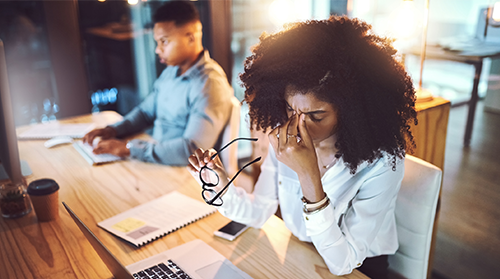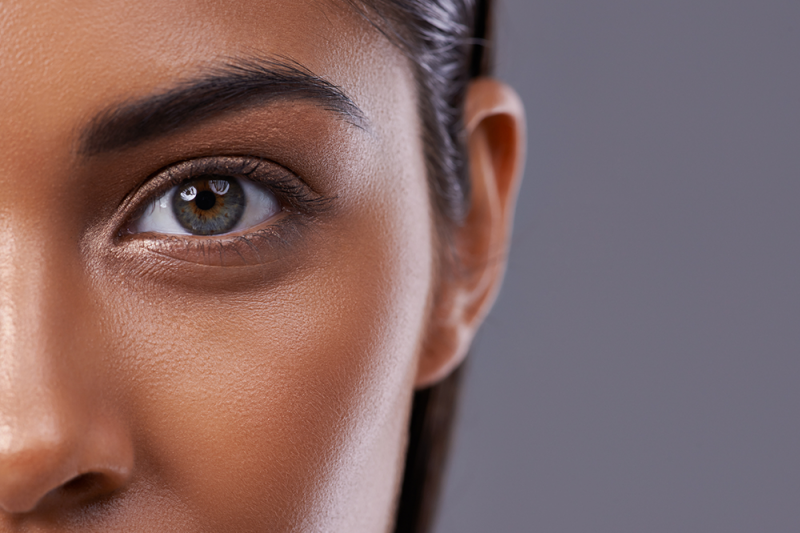
A woman sitting in front of a computer has removed her glasses and is rubbing her tired eyes. A male colleague sits along the table from her.
It’s more likely than not you’re reading this on a screen.
If you’ve been looking at a computer screen or your smart phone for a long period of time, when was the last time you looked away?
It’s no surprise that the use of any digital device has increased substantially in recent years. Digital eye strain, which has also aptly been named computer-vision syndrome, includes a wide range of ocular (to do with the eyes) and visual symptoms.
Studies estimate that more than 50% of computer users suffer from some form of computer induced eye strain. According to the American Optometric Association, the most common symptoms associated with digital eye strain are eye strain (😊), headaches, blurred vision, dry eyes and even pain in the neck and shoulders. So, if your eyes are burning, highly irritable, tearing up, or dry often during your day, it’s time to do something about it!
Just like we advocate for self-care for our minds and bodies, why not try these eye self-care tips the next time your eyes are feeling tired.
Blink more
On average, most people blink around 15 to 20 times each minute, but when you throw increased computer use into the equation, you tend to blink less, which can contribute to that not-so-pleasant dry-eye feeling.
Did you know that blinking cleans the surface of your eye? It clears away debris and washes your eye’s surface with fresh tears, which helps to sharpen your vision by clearing and brightening the image your retina receives. That’s pretty clever if you ask us.
If your eyes are feeling fatigued, try to make a habit of blinking more often when you’re looking at a monitor or screen.
If you have more than one screen, try and blink each time you look at a different screen, or when you see a notification pop up. If you’re actively thinking of blinking more, it is more likely than not that you’ll start to subconsciously do it.

Take eye breaks
Just as you regularly take breaks to break up your workday, taking eye breaks can also help take some of the strain away. Why not try the 20-20-20 rule, where every 20 minutes you look at something at least 20 feet (6m) away for at least 20 seconds. The idea is to change the distance your eyes are focusing on, so they are not at the same focus point all day. Not only will staring off into the distance make you look like you’re deep in thought, but it’s also beneficial to your eyes!
Check the lighting
If you’re finding yourself more sensitive to glare when you’re looking at the computer, it’s time to check the lighting. Bright lighting or too much glare might be wreaking havoc on your ability to see your monitor clearly and focus on what you’re looking at. The worst offenders for light issues generally come from above or behind you, including office staples like overhead fluorescent lighting, or for those lucky enough to have window views, sunlight.
Although it may not be possible, try turning off or dimming the overhead lights and closing the blinds to reduce natural glare. You can also try fitting an anti-glare cover over your screen.
Adjust your monitor
Workstation ergonomics is not just a fancy term thrown around by HR. It’s vital to ensuring your workstation is supporting you as much as possible, in particular the positions of your monitors.
Ideally, you want your monitor/s directly in front of you, roughly an arm’s length away. The top of your screen should be at or just below eye level, so your neck is in a neutral position to eliminate any unnecessary neck strain.
Another useful adjustment tip is to look at your monitor’s settings. Enlarging the type size will make it easier for your eyes to read while adjusting the contrast and brightness settings can also help.
Use a document holder
If you are working off printed material and need to refer to it regularly while using your computer, try popping it on a document holder. There are many designs and styles out there, but the goal is to minimise how much to-and-fro your eyes, head and neck do.
Eye strain might sound like something you could simply deal with, but it’s best to be proactive about making sure you don’t need to. Although some eye complaints are very common and can often be solved with a simple fix, it’s best to see an optometrist or a doctor if any issues persist.